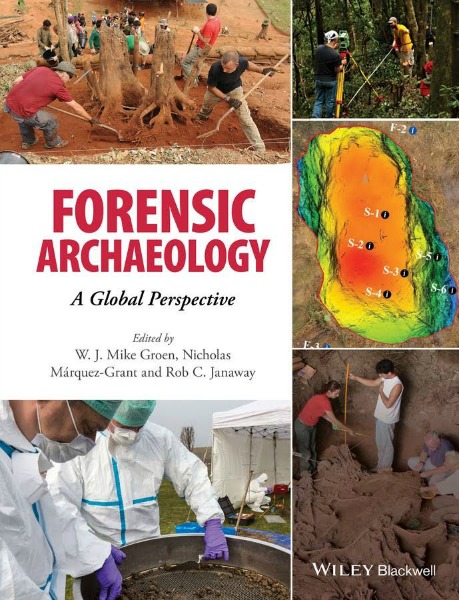Forensic Archaeology
Forensic Archaeology is a specialized discipline within the broader field of Forensics which applies archaeological techniques and methods in order to assist in the location, recovery, and documentation of evidence (including human remains) within a legal context.
Want To Study Forensics/CSI?
Dr Hannah Koon talks about forensic archaeology, why it’s important and what careers it can lead to.
Real World Forensic Archaeology
The mission of the U.S. Military Joint prisoner of war/missing in action accounting command (JPAC) is to achieve the fullest possible accounting of all Americans missing as a result of the nation's past conflicts.
In the context of this mission forensic archaeology involves locating and defining missing U.S. personnel loss locations, and then recovering human remains and other material evidence associated with missing, or otherwise previously unrecovered, deceased U.S. service personnel. These activities are considered to be forensic archaeology, because they are required to provide data that will support legally defensible identifications.
|
The Central Identification Laboratory (CIL) treats each recovery scene as if it were a crime scene, whether related to a criminal case or not. This is so that each scene is managed according to appropriate forensic principles and procedures that provide for the security of evidence and maintenance of the chain of custody. |
|
Evidence recovered by JPAC recovery teams was typically deposited over 30 years ago. Consequently, most sites have become incorporated into the archaeological record and require subsurface archaeological recovery techniques. Archaeological principles (largely the principles of stratigraphy) provide the basis for interpretation of the context in which remains and evidence are recovered.
Although the CIL is most used to dealing with 'single event' loss incident scenes, successful interpretation of stratigraphy can be used to illustrate the event history of a loss incident and all subsequent human activity or natural processes at a scene. Stratigraphy is a collection of value neutral relationships, which through careful observation can lead to useful and manageable interpretations of what are sometimes very complicated processes and patterns.
Forensic Archaeologists need stratigraphy to demonstrate evidence integrity and association. By interpreting the stratigraphy of a site/scene sufficiently well, the CIL's Forensic Archaeologists can transfer the spatial relationships and chronological history of a recovery scene to paper and thus make it comprehensible to others who may not have been present at the time of recovery. Without the use of stratigraphy, any evidence collected from a scene becomes disassociated and unprovenienced, i.e. much less useful.
The general principals upon which CIL recoveries are based are:
The Law of Superimposition
The Law of Superimposition is the most basic law of stratigraphy, and it is also the one by which most recovery scenes are interpreted. It states that, when the stratigraphic record is normally oriented any stratigraphic unit that underlies another must be older than the overlying unit.
The Law of Inclusion
Any item (or evidence) contained within a deposit must be older than the deposit and the process by which the deposit was laid down. This can extend to anthropogenic materials (the bricks in a wall must be older than the wall etc.). Occasionally, soil and/or sediment formation processes can result in the mobility of objects throughout the stratigraphic record. Earthworms are a good example of a creature, whose behavior sometimes results in the movement of evidence within the archaeological record through a process called 'bioturbation' - the disturbance of soils and sediments by living organisms. This results in an apparent exception to the law of inclusion; however, in reality the law holds, but our ability to discern the newly homogenized deposit, created by the earthworms, is very limited.
The Law of Association
The nature of the chronological and spatial relationship between two objects within a stratigraphic unit is determined by the integrity of that stratigraphic unit. Two flint cores and a flint flake scatter found centimeters apart within a cave tufa, which itself underlies many meters of other undisturbed sediment is an 'association' (the cores and flakes are in the same deposit) and may be used as evidence of a relationship (the deposit is undisturbed and 'sealed'). The discovery of a can-opener and a cellular phone battery in the fill of a garbage tip is also an association - they are in the same deposit. However, this association is not likely to be evidence of a direct relationship between the items (the deposit is heavily disturbed, and is not 'sealed').
The law of association is sometimes a difficult principle to apply because even in the example given above, the long time depth required to produce a sealed deposit of cave tufa means that the cores and flakes may not have been deposited in the same incident and throws doubt on the strength of the relationship. The famous "Laetoli footprints" are a good example of how the law of association can be used to create multiple interpretations, and how simple it is to weaken assertions made under this law. The Forensic Archaeologists at the CIL have considerable professional expertise in interpreting this difficult issue.
The Law of Crosscutting Relations
Any feature that intrudes into a deposit must be younger than the deposit into which it intrudes. A grave is always younger than the soil into which it is dug.
Much of the understanding of depositional environments, and hence the understanding of stratigraphy, is based on the Principle of Uniformitarianism. This principle, which Anthropologists usually find difficult to sustain when applied to many aspects of human behavior, states that the way processes occur in the present is the way they occurred in the past. So, if a particular type of river regime leaves behind a characteristic sediment signature when we observe it in the present day, and we find the same sediment signature in the archaeological or geological record we assume the same type of river regime was operating in the past. Obviously there are limitations to this approach, but, by and large, it leads to sound, internally consistent, interpretations of stratigraphy that is not deliberately man-made.
It is the use of principles, such as the law of association, superimposition, cross-cutting relationships and inclusion, etc., that allow the Forensic Archaeologists of the CIL to determine an internally consistent order of events within a defined area - the recovery scene perimeter. For example, all evidence recovered from stratigraphic unit 'A' is older relative to that discovered in stratigraphic unit 'B'. These relative chronologies make no definitive statements about how much older evidence from unit 'A' is than in unit 'B.'
The process of recovery is unavoidably destructive. Through the collection and removal of evidence from recovery scenes, actual spatial relationships and associations between transportable and non-transportable evidence are permanently lost. All JPAC recovery scene personnel are responsible for ensuring that the loss of these physical relationships is mitigated as far as possible. This mitigation is achieved by the following goals of any CIL recovery:
- Selecting a recovery strategy that maximizes data recorded and physical evidence recovered from a scene in order to minimize the loss of physical evidence and other pertinent data (e.g., associations between material evidence and human remains).
- Establishing and fully documenting the context in which all evidence is found. The recording of all spatial and contextual associations should be such that any subsequent identification process will not be hindered or compromised.
- Recovering all relevant evidence from the recovery scene.
- Securing, storing and stabilizing evidence from the point of its recovery to its accession into the CIL.
- Maintaining a chain of custody through documentary and photographic records that link the recovered evidence to the recovery scene.
Successful attainment of these goals ensures that the JPAC can demonstrate, post-recovery:
- Any direct associations between physical evidence and a recovery scene.
- The association of evidence not directly part of an individual's remains to any particular recovered individuals.
All recovery scenes are meticulously documented and these maps, surveys, notebooks and catalogues are used to support the Forensic Archaeologist's written and illustrated report. This report, like all the reports by the Scientific Staff of the JPAC is subject to intensive internal and external peer review. Once peer review is complete, the report is submitted to the Scientific Director of the CIL who may use it to support identifications.
Essential Reading
Forensic archaeology is mostly defined as the use of archaeological methods and principles within a legal context. However, such a definition only covers one aspect of forensic archaeology and misses the full potential this discipline has to offer. This book is unique in that it contains 57 chapters from experienced forensic archaeological practitioners working in different countries, intergovernmental organisations or NGO’s. It shows that the practice of forensic archaeology varies worldwide as a result of diverse historical, educational, legal and judicial backgrounds.
The chapters in this volume will be an invaluable reference to (forensic) archaeologists, forensic anthropologists, humanitarian and human rights workers, forensic scientists, police officers, professionals working in criminal justice systems and all other individuals who are interested in the potential forensic archaeology has to offer at scenes of crime or places of incident. This volume promotes the development of forensic archaeology worldwide. In addition, it proposes an interpretative framework that is grounded in archaeological theory and methodology, integrating affiliated behavioural and forensic sciences.
See following link for full details.
Forensic Archaeology: A Global Perspective
Recent Articles
-
All About Forensic Science
Nov 12, 24 03:05 AM
A forensic science website designed to help anybody looking for detailed information and resources. -
The Role of Forensic Evidence in Criminal Defense Cases
Sep 05, 24 03:38 AM
Article exploring five key roles that forensic evidence plays in criminal defense cases -
The Evolving Role of Medical Science in Forensic Investigations
Aug 06, 24 03:35 AM
Insightful article exploring the critical role of medical science in forensic investigations.



New! Comments
Have your say about what you just read! Leave me a comment in the box below.